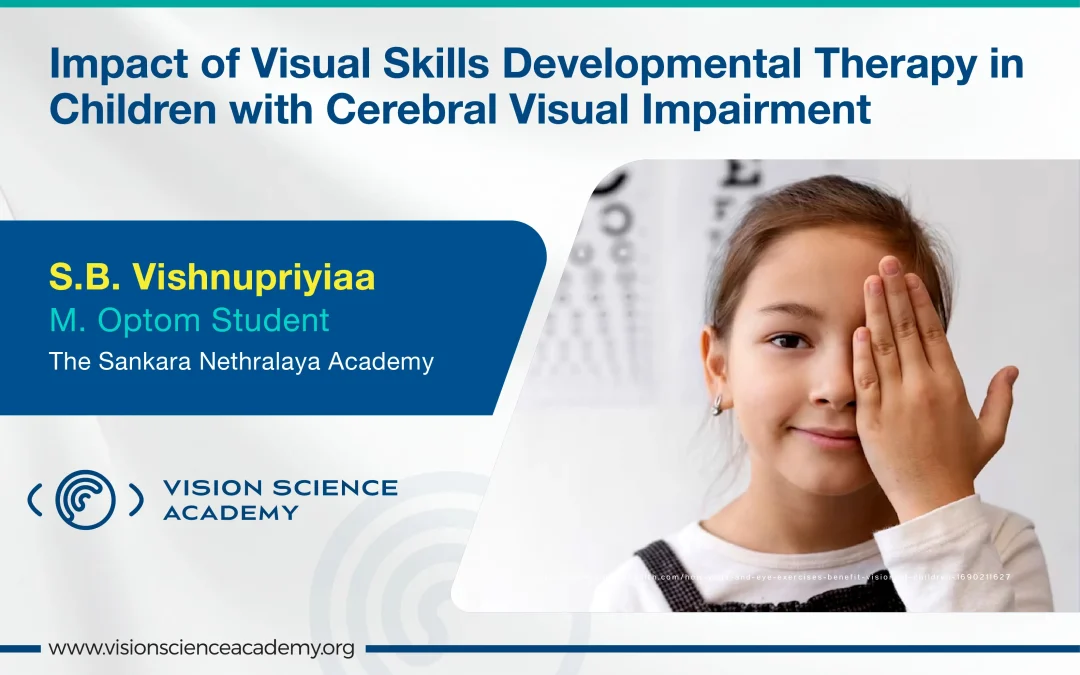S.B.Vishnupriyiaa, B. Optom.
M. Optom Student, The Sankara Nethralaya Academy, Chennai, India
Cerebral Visual Impairment (CVI) is a leading cause of visual dysfunction in children, resulting from damage to the visual processing centre of the brain rather than the eyes. This condition affects the ability of the children to interpret visual information, leading to developmental challenges in motor skills, cognition, and daily functioning. Early intervention through visual skills developmental therapy is crucial in mitigating these challenges and fostering optimal growth.
Understanding CVI and Developmental Impact
CVI arises from factors such as perinatal hypoxia, brain injuries, infections, or genetic disorders. Children with CVI often face challenges with depth perception, facial recognition, and light sensitivity, leading to delayed motor development due to impaired spatial awareness. Consequently, activities requiring hand-eye coordination, balance, and navigation become more challenging, affecting the overall functionality of the child. (1)
The Role of Visual Skills Developmental Therapy
Visual skills developmental therapy aims to enhance the ability of the brain to process visual information, improving functional vision and overall development. Occupational therapists typically design individualised intervention plans, incorporating key strategies such as:
- Environmental Modifications: Minimising visual clutter and enhancing contrast can improve focus and recognition. High-contrast materials and simplified visual stimuli help children process visual information more effectively.
- Sensory Integration: Activities that combine visual input with touch and movement strengthen neural pathways, facilitating better integration of visual and motor responses.
- Task-Specific Training: Purposeful activities such as drawing, puzzles, and ball games enhance visual attention and tracking abilities. These tasks are gradually adapted to match the progress of the child, ensuring continuous skill development.
- Assistive Technology: Tools like screen readers, magnification devices, and specialised software support visual learning, making educational and daily activities more accessible. (2-4)

Figure 1: Toys for Kids with CVI
Evidence Supporting Therapy
Research underscores the importance of early and targeted intervention in improving outcomes for children with CVI. A study demonstrated improvements in visual attention and motor task integration among children receiving specialised visual skills therapy. The American Academy of Paediatrics also emphasises the importance of early detection and management of CVI to enhance educational outcomes and development. (5)
Challenges and Considerations
Despite its benefits, providing effective therapy for children with CVI presents challenges. The wide variability in symptoms necessitates individualised therapy plans, requiring continuous assessment and adjustments. Additionally, increased awareness and training among healthcare providers and educators are essential for recognising CVI and implementing appropriate interventions. A multidisciplinary approach involving neurologists, ophthalmologists, occupational therapists, and educators is crucial to addressing the complex needs of children with CVI comprehensively.(6)
Conclusion
Visual skills developmental therapy plays a vital role in supporting children with Cerebral Visual Impairment. By improving the visual processing abilities of the brain, this therapy enhances visual function, motor skills, cognition, and overall quality of life. Early identification and intervention are essential in maximising benefits, underscoring the need for heightened awareness and resources dedicated to this population. (7)
References
- American Academy of Pediatrics. (2024). Diagnosis and Care of Children With Cerebral/Cortical Visual Impairment. Pediatrics, 154(6), e2024068465. https://doi.org/10.1542/peds.2024-068465 (5)
- Rowe, F. J., & Dutton, G. N. (2023). Occupational Therapy Assessments of Cortical or cerebral Visual Impairment in Children. American Journal of Occupational therapy, 77(6), 7706205160. https://doi.org/10.5014/ajot.2023.050160
- Connor, A. R., & Tidbury, L. P. (2024). Cortical Vision Impairment (CVI)-informed assessment and treatment of children with SCN2A-Related Disorder.
- Bruegger, T. J., Carroll, A., Dutton, C., Dietrick, J., Cook, C., & Eller, B. (2023). Examining the Effect of Eye Gaze Technology on Children With Cortical Visual Impairment.
- Neurolaunch Editorial Team. (2024). Cortical Visual Impairment: Occupational Therapy Approaches for Improved Functionality.
- Chokron, S., Dutton, G. N., & Boonstra, F. N. (2022). Editorial: Cerebral visual impairment, visual development, diagnosis and rehabilitation.
- Ortibus, E., Laenen, A., & De Cock, P. (2022). From vision to cognition: potential contributions of cerebral visual impairment to intellectual disability in children.


Recent Comments